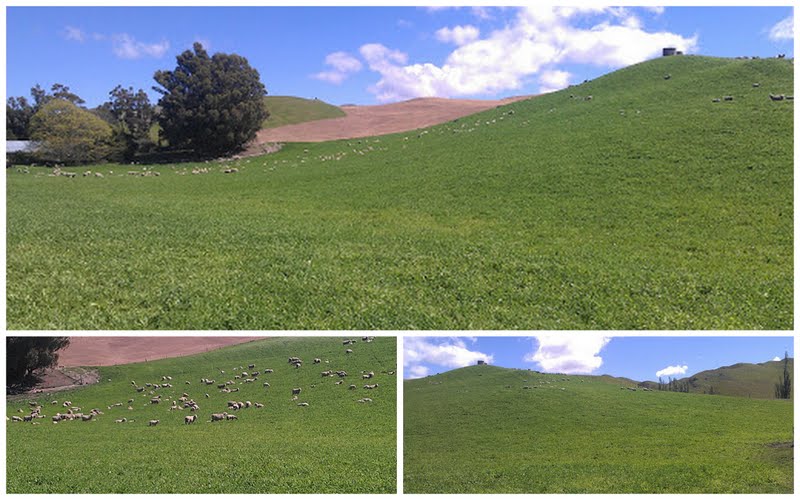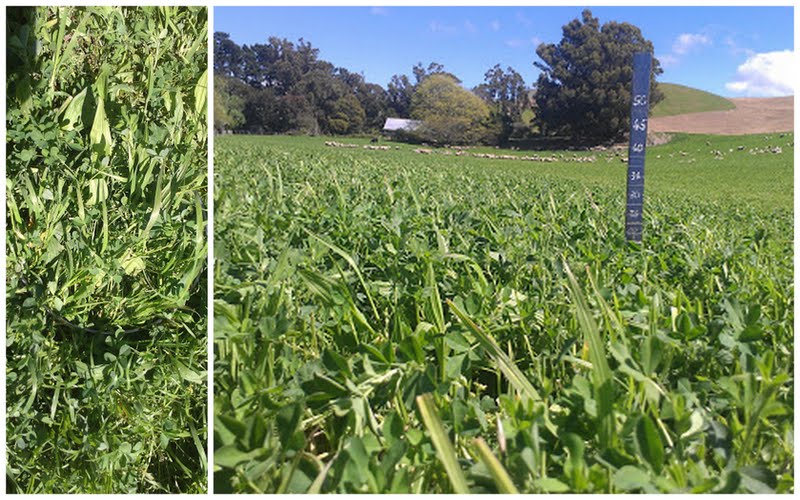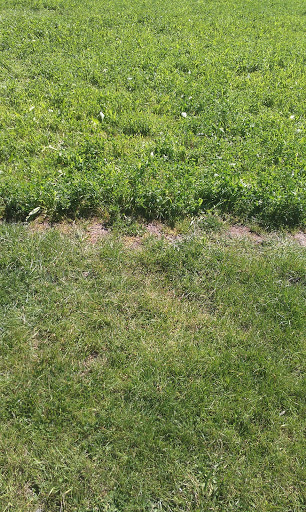Fraser and Doug have got the cull ewes and their lambs grazing on Glen Erin at the moment, plus a handful of Friesian bulls. The paddock is currently split into two with an electrified break-fence. The Avery’s are developing their stock water system to increase trough numbers, so that they can subdivide paddocks by break fencing when required.
This paddock is still performing very well by providing high quality feed to lactating ewes and their lambs. The actual lamb growth rate for these particular lambs is 305 grams/head/day. This growth rate is taken from the actual weight of individual lambs from tailing to now. The triplets seem to be the stars of the show at Bonavaree at the moment – growing 355 g/day. The farm average for this season is 330-340 g/hd/d. This data is able to be utilised by the Avery’s because of their voluntary application of EID tags in their ewes and lambs. Fraser said the extra work to tag the lambs with EID is not a hassle, and is easy to do as part of the tailing process. The biggest benefit will be realised when the technology is used to be able to identify their best animals overtime, and lift overall animal performance.
Fraser and Doug are on-track for a 25th November weaning date, although there will be one cut of lambs drafted out before then. This is later than usual due to the check the lambs got from the wet start.
The average pasture height in Glen Erin is between 20-22 cm. You will notice in the foreground of these photos (below) that the botanical composition of this sward has changed since our last visit. The plantain and lucerne are more obvious, whereas at our last visit the prairie grass was becoming more dominant in the sward. Fraser made the comment last time that he may get back to Glen Erin quicker than a lucerne rotation length in order to control excessive Prairie Grass growth. These sheep were moved onto this paddock after 28 days break. With soil and air temperatures improving as the spring progresses, all species within this Bonavaree mix should be able to compete well with each other. Although, Doug and Fraser acknowledge that a dry year will be the real test for this mix.
There were a few Plantain and Prairie Grass plants flowering when we visited. Fraser used the first summer of this paddock to replenish the seedbank of the sown species, by shutting it up and allowing it to set seed. This year the paddock will be included fully within the grazing rotation.
You can see by the photo (left) how the pasture species composition in this paddock has been improved, and the quantity of dry matter increased. The bottom of the photo shows the headlands of the existing pasture species, with the Bonavaree mix growing at the top.
Paddocks such as this offer flexibility as to when the Avery’s will wean. If the dry starts earlier than normal, then they can wean earlier and use these top performing paddocks as lamb finishing feed.
Key Bonavaree messages:
- Building flexibility into the farm system is the key to success.



Doug and Frazer
Great to see such quality feed for lambs, no wonder they are growing so fast. I have tried this mix with great success and have sown more this spring. Just wondering what your sowing rates were. I sowed 6kg lucerne, 14kg Prairie, 2kg Vision cocksfoot, 2kg plantain and 2kg huia white clover. I am wondering if we should sow more lucerne in this mix. Any thoughts?
Have seen some ewes and lambs today targeting cocksfoot in a sward of sub, rye, older cocksfoot, plantain etc. I think the cocksfoot is all part of the diet on offer, but it can dominate if it gets to tall, which maybe dosent suit a lucerne mixed sward. Any thoughts.
Mark Zino.
Hi Mark,
We sow 9 of lucerne,15 kgs of Prairie and 1 kg of plantain. It gets a quick nip after it is well up and then shut till mating time. By then it has prairie grass seeding and lucerne flowers setting seed as well. Some say this is not good mating feed but ewes on this last year mated 198%. Because the paddocks we sow in lucerne have been through at least a two year crop rotation, deep soil moisture has always built up. This way on our soils we can gauantee mating feed every year regarless of the season. A PHD student working with Derrick Moot has measured lucerne root growth from sowing till first flowering at 13 mm per day. What a great plant
Hi Mark, the sowing rates look about right- Prairie is the largest of those seeds. It prefers pH over 6.0 and will give you some early spring growth. Cocksfoot is likely to dominate if you get frequent small summer rainfall events. It is just as palatable as ryegrass provided nitrogen is available and the lucerne provides that. I suspect the plantain will struggle after about 3-4 years but until then is also high quality. To manage – late summer before you let the lucerne flower nail the whole pasture with ewes – that should keep you on top of the cocksfoot. The more summer rain you get the more the cocksfoot will be an issue. In <500 mm rainfall it works well.
I should also add. Drilling takes place here on about the 15th of October. The sowing depth is for the lucerne, 1-2 cms. All subsequent paddock management is around what is best for lucerne. This means prairie grass and plantain is always being grazed past its “best bye” date. Stock performance on this mix is the best I have seen on this farm. During winter and prairie grass fills in feed gaps well. This mix also is the dream mix for nitrogen creation and use.
Hi Doug,
If you are not going to cut a paddock
for hay. What do you think of adding
chicory to the mix?
Cheers
Roger Beattie
Hi Roger……….. how are the Weka’s? Love following your progress!
Problem with chicory is it has such a thick stalk and that takes so long to dry in the hay making process. While that is happening the lucerne quality is falling.
It works well though, in grazing systems.